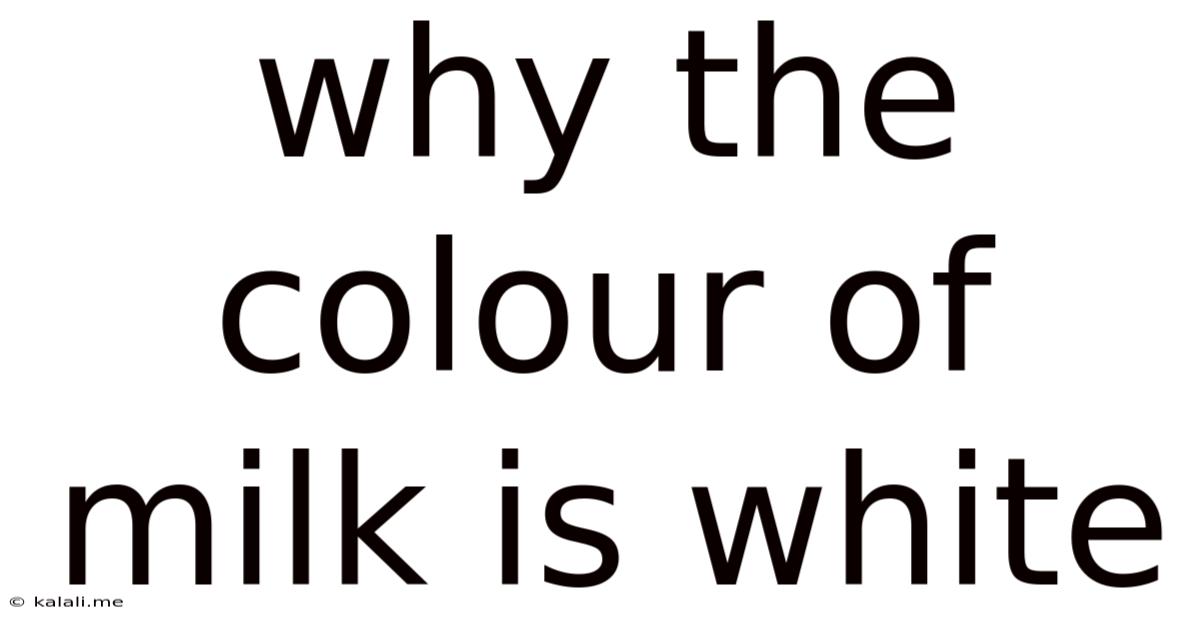Why The Colour Of Milk Is White
Kalali
Jun 11, 2025 · 2 min read

Table of Contents
Why is Milk White? Unraveling the Science Behind the Creamy Hue
Milk, a staple in many diets worldwide, boasts a characteristically creamy white color. But have you ever wondered why? The answer isn't as simple as it might seem, delving into the fascinating world of light scattering and the composition of milk itself. This article explores the scientific reasons behind milk's white color, demystifying this everyday observation.
The Role of Light Scattering: Tyndall Effect in Action
The primary reason milk appears white is due to a phenomenon called the Tyndall effect. This effect occurs when light passes through a colloid – a mixture containing particles dispersed throughout a medium. Milk is a perfect example of a colloid, with tiny fat globules (milk fat) and casein micelles (milk protein) suspended in water.
When light strikes these particles, it's scattered in all directions. This scattering happens across the entire visible spectrum (red, orange, yellow, green, blue, indigo, violet). Because all colors of light are scattered equally, our eyes perceive the combined effect as white. This is in contrast to clear liquids like water, which allow light to pass through largely unscattered.
The Composition of Milk: Fat, Protein, and Light
The concentration of fat and protein in milk significantly influences the intensity of its white color. Whole milk, with its higher fat content, generally appears whiter and creamier than skim milk, which has a lower fat percentage. This is because the fat globules contribute significantly to the light scattering process. The size and number of these fat globules influence the overall whiteness and opacity.
Other Contributing Factors
While the Tyndall effect and the composition of milk are the key players, other factors can subtly influence the perceived color:
- Breed of Animal: The milk from different animal breeds can vary slightly in color and composition, leading to minor differences in whiteness.
- Diet of the Animal: The animal's diet can also affect the milk's composition and therefore its appearance.
- Processing: Any processing of milk, such as homogenization (reducing fat globule size), can influence the light scattering and the perceived whiteness.
Beyond White: Variations in Milk Color
While most milk appears white, slight variations can occur. Some milk may have a slightly yellowish tint, which can be attributed to the presence of beta-carotene, a pigment also found in carrots and other yellow-orange vegetables. The intensity of this yellowish hue can vary based on the animal's diet and breed.
Conclusion: A Complex Interaction of Light and Matter
The seemingly simple question of why milk is white reveals a complex interaction between light, the colloidal nature of milk, and the specific composition of its components. The Tyndall effect, in conjunction with the scattering of light by fat globules and protein micelles, creates the characteristic white color we associate with this essential food source. Understanding this intricate interplay offers a fascinating glimpse into the science behind everyday observations.
Latest Posts
Latest Posts
-
How Many Cups In A 16 Oz Sour Cream
Jul 02, 2025
-
How Many 1 4 Teaspoons Are In 1 Teaspoon
Jul 02, 2025
-
How Many Tbsp In A Dry Ounce
Jul 02, 2025
-
How Do You Say Grandparents In Spanish
Jul 02, 2025
-
How Many Numbers Are Between 48 To 24
Jul 02, 2025
Related Post
Thank you for visiting our website which covers about Why The Colour Of Milk Is White . We hope the information provided has been useful to you. Feel free to contact us if you have any questions or need further assistance. See you next time and don't miss to bookmark.